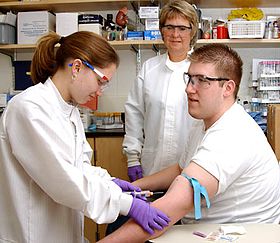
Phlebotomy

Phlebotomy is the process of making a puncture in a vein with a needle, for the purpose of taking blood. The procedure itself is known as a venipuncture. A person who performs phlebotomy is called a 'phlebotomist', although doctors, nurses, medical laboratory scientists and others do portions of phlebotomy procedures in many countries. It is not to be confused with phlebectomy. Phlebotomy is the process of making a puncture in a vein with a needle, for the purpose of taking blood. The procedure itself is known as a venipuncture. A person who performs phlebotomy is called a 'phlebotomist', although doctors, nurses, medical laboratory scientists and others do portions of phlebotomy procedures in many countries. It is not to be confused with phlebectomy. Phlebotomists are people trained to draw blood from a patient (mostly from veins) for clinical or medical testing, transfusions, donations, or research. Phlebotomists collect blood primarily by performing venipunctures (or, for collection of minute quantities of blood, finger sticks). Blood may be collected from infants by means of a heel stick. The duties of a phlebotomist may include properly identifying the patient, interpreting the tests requested on the requisition, drawing blood into the correct tubes with the proper additives, accurately explaining the procedure to the patients, preparing patients accordingly, practising the required forms of asepsis, practising standard and universal precautions, performing the skin/vein puncture, withdrawing blood into containers or tubes, restoring hemostasis of the puncture site, instructing patients on post-puncture care, ordering tests per the doctor's requisition, affixing tubes with electronically printed labels, and delivering specimens to a laboratory.
